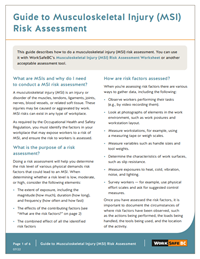Vibration
Vibration is a risk factor for a number of conditions including injuries to the fingers and hands and back. Two types of vibration hazard can affect workers: hand-arm vibration and whole-body vibration.
- The risks
- Assessing the risks
- How to reduce the risks
- Resources
The risks
|
Hand-arm vibration |
Vibrating objects such as power tools send vibration through the hands and arms |
|
Whole-body vibration |
Vibrating surfaces where a worker stands or sits send vibration throughout the body |
Other risk factors can increase the likelihood of injury from vibration:
- Working in cold, damp environments
- Increased grip force
- Using a vibrating tool for long periods
Assessing the risks
- Employers must conduct risk assessments for musculoskeletal injuries (MSIs) in their workplace, and eliminate or minimize the risks. Employers must also educate and train workers about MSI risks in the workplace.
- To get started, use our Guide to Musculoskeletal Injury (MSI) Risk Assessment and Musculoskeletal Injury (MSI) Risk Assessment Worksheet. These can help guide your assessment of the extent of a worker's exposure to vibration. This will help you determine how great a risk a particular task poses
How to reduce the risks
When choosing the appropriate risk controls, the employer must consult with the joint health and safety committee or the worker health and safety representative. Be sure to test the risk control before fully implementing to make it work within your organization. To help identify potential risk controls, consider the following questions:
-
1
Engineering controls
These controls involve making physical modifications to facilities, equipment, and processes to reduce exposure. Key questions to consider:
- Can different tools be used that do not generate as much vibration?
- Can seating be improved and/or cushions provided?
- Can matting be installed?
- Can a process be used that generates less vibration?
-
2
Administrative controls
These controls involve changing work practices and work policies, awareness tools, and training to limit the risk of vibration exposure. Some questions to consider:
- Can limits be set for how long a worker performs a task? Can job rotation be used?
- Can frequent breaks be scheduled for workers?
-
3
Personal protective equipment
This control, the least effective, must always be used in addition to at least one other control. Some questions to consider:
- Do workers have vibration-dampening personal protective equipment such as gloves and hand tool wraps?
- Is the personal protective equipment effective in reducing exposure to vibration?


